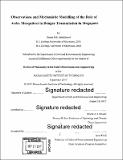| dc.contributor.advisor | Elfatih A. B. Eltahir. | en_US |
| dc.contributor.author | Seidahmed, Osama M. E. (Osama Mohamed Elmekki) | en_US |
| dc.contributor.other | Massachusetts Institute of Technology. Department of Civil and Environmental Engineering. | en_US |
| dc.coverage.spatial | a-si--- | en_US |
| dc.date.accessioned | 2018-02-08T16:26:17Z | |
| dc.date.available | 2018-02-08T16:26:17Z | |
| dc.date.copyright | 2017 | en_US |
| dc.date.issued | 2017 | en_US |
| dc.identifier.uri | http://hdl.handle.net/1721.1/113492 | |
| dc.description | Thesis: Ph. D., Massachusetts Institute of Technology, Department of Civil and Environmental Engineering, 2017. | en_US |
| dc.description | Cataloged from PDF version of thesis. | en_US |
| dc.description | Includes bibliographical references (pages 182-209). | en_US |
| dc.description.abstract | Dengue is the most prevalent human arboviral disease in the world with an estimate of 390 million cases per year. The disease is mainly transmitted by two mosquitoes: Aedes aegypti and Ae. albopictus. Despite the continuous efforts to curb the spread of the disease in Singapore, there is an upsurge in dengue epidemics. In this thesis, the role of Aedes mosquitoes in shaping the spatiotemporal patterns of dengue transmission in Singapore is investigated. Field surveys are carried out to study the effect of monsoons on the disease vectors; the impact of urban housing on spatial patterns of dengue transmission is explored; and mechanistic models are developed to simulate the seasonality of dengue occurrence in the city. The role of monsoons in shaping the seasonal pattern of dengue is investigated. Singapore has no pronounced dry season, while dengue cases decrease every year after a very wet monsoon. A preliminary survey documents that Aedes mosquitoes breed in drains close to houses. A hypothesis that the very wet monsoon results in a strong reduction of outdoor breeding of Aedes is tested using field data. A one-year entomological survey confirms the hypothesis and shows that a monsoonal sequence of flushing-drying conditions in the drains shapes the seasonal abundance of Aedes in Singapore. This finding can be used to optimize vector control efforts and to better understand dengue transmission in the context of climate change. The influence of urban housing on the distribution of dengue at neighborhood and country scales is studied. Dengue incidence, vector abundance, and drainage network density are found to be higher in a subarea of low-rise housing in Geylang. Further, a holistic analysis at the country-scale confirms the role of urban housing in shaping spatial patterns of dengue. Dengue incidence is found to be proportional to the fraction of the area (or population) of low-rise housing. This finding suggests that affording public housing in agglomerations of high-rise buildings would have a positive impact on dengue control if this urban housing develops at the expense of low-rise areas. A mechanistic model is developed to investigate the role of drainage networks in the outdoor breeding of Aedes and transmission of dengue virus. The HYDRology, Entomology and DEngue Transmission Simulator (HYDREDETS) consists of three coupled dynamic models, with an explicit representation of the spatial domain. The model is calibrated using field observations to study rainfall-effects on flushing/drying of aquatic stages and re-inoculation by dormant eggs. Dengue vertical transmission and the role of human movements are incorporated in the model. HYDREDETS is capable of simulating patterns of dengue transmission in Singapore, however with reduced seasonality. This finding supports the hypothesis that dengue seasonality in Singapore can be attributed to a significant degree, to flushing-drying sequence in outdoor breeding habitats. Based on the conclusions of this thesis, spatiotemporal patterns of dengue in Singapore are shaped by climate and urban ecology which influence the ecology of Ae. aegypti and Ae. albopictus. HYDREDETS is a new modeling tool tailored to the study of vector-borne diseases related to urban hydrology. Dengue vector control can be optimized using these new tools and the improved understanding of the disease ecology. | en_US |
| dc.description.statementofresponsibility | by Osama M. E. Seidahmed. | en_US |
| dc.format.extent | 209 pages | en_US |
| dc.language.iso | eng | en_US |
| dc.publisher | Massachusetts Institute of Technology | en_US |
| dc.rights | MIT theses are protected by copyright. They may be viewed, downloaded, or printed from this source but further reproduction or distribution in any format is prohibited without written permission. | en_US |
| dc.rights.uri | http://dspace.mit.edu/handle/1721.1/7582 | en_US |
| dc.subject | Civil and Environmental Engineering. | en_US |
| dc.title | Observations and mechanistic modelling of the role of Aedes mosquitoes in dengue transmission in Singapore | en_US |
| dc.type | Thesis | en_US |
| dc.description.degree | Ph. D. | en_US |
| dc.contributor.department | Massachusetts Institute of Technology. Department of Civil and Environmental Engineering | |
| dc.identifier.oclc | 1020068141 | en_US |
